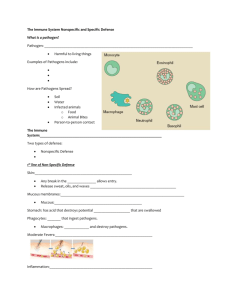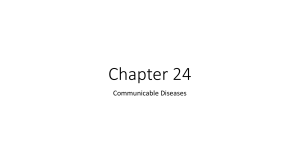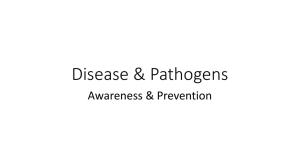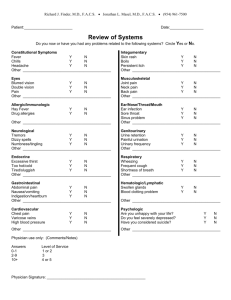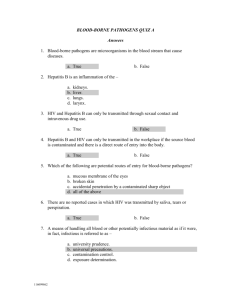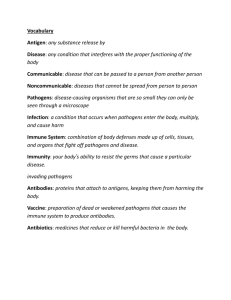Communicable & Chronic Diseases
advertisement
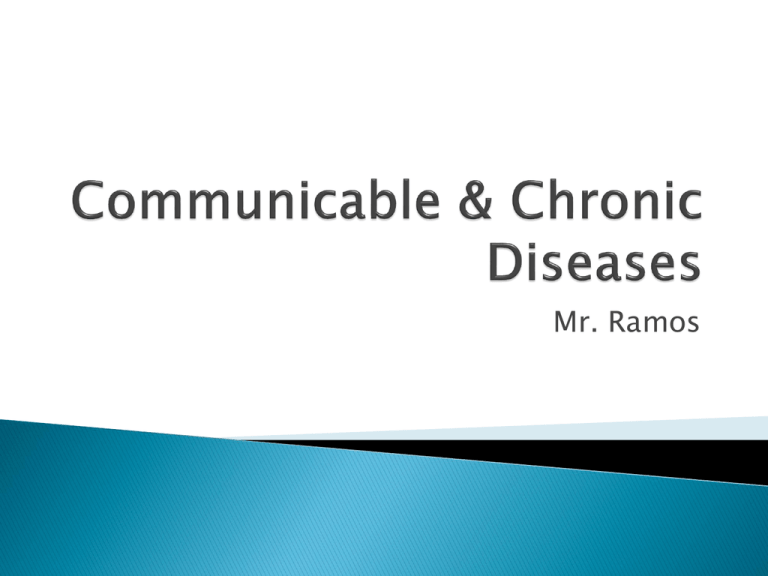
Mr. Ramos Objectives: ◦ Discuss the ways in which pathogens can be spread ◦ Describe the immune system and how it responds to pathogens ◦ List ways to keep the immune system healthy, including getting adequate rest A germ, or pathogen, is something that causes disease. Examples of pathogens include bacteria, viruses, protozoa, and fungi. Not all bacteria, viruses, protozoa, and fungi are pathogens. A communicable disease is an illness caused by a pathogen that can be passed to a person from another person, animal, or object. ◦ Examples: Common cold and the Flu Pathogens may be spread when an infected agent comes into direct contact with a noninfected agent. ◦ Touching, kissing, sharing eating utensils, or exchanging bodily fluids, as in sexual activity or needle sharing. Pathogens may also spread indirectly through contact with doorknobs, tabletops, faucet handles, and other surfaces. Type of Pathogen Description Diseases Bacteria Bacteria are single-celled microorganisms that live nearly everywhere. When disease-causing bacteria enter a person’s body, they rapidly reproduce. Strep throat, Lyme disease, and urinary tract infections Viruses Viruses are the smallest and simplest pathogens. They are not living organisms. However, they can reproduce inside living cells Colds, chicken pox, small pox, measles, herpes Type of Pathogen Description Diseases Protozoa Protozoa are singlecelled organisms that may capture other tiny life forms for food. Some protozoa can live within the human body as parasites. Malaria, dysentery Fungi Fungi are single-celled or Athlete’s foot, ringworm, muticelled organisms nail fungal infections that feed on organic material. Yeasts and molds are two types of fungi that may cause illness. Type of Pathogen Description Diseases Rickettsia Rickettsia are a special type of bacteria that multiply like viruses. Rickettsia species are carried by many ticks, fleas, and lice. Typhus, Rocky Mountain spotted fever The immune system is the body’s defense against pathogens. The immune system is made up of cells, tissues, and organs. The immune system has three lines of defense: ◦ First line of defense ◦ Second line of defense ◦ Third line of defense The first line of defense: ◦ Skin – unbroken skin provides a barrier against pathogens ◦ Mucous membrane – tissue that lines the nose, mouth, and throat. Mucous is the sticky ◦ Tears – contain chemicals that destroy pathogens ◦ Saliva - contain chemicals that destroy pathogens ◦ Sweat - contain chemicals that destroy pathogens ◦ Stomach acid – destroys pathogens that survive in the mouth & throat The second line of defense: ◦ If pathogens pass the first line of defense, the body launches the second line of defense. ◦ This is a nonspecific immune response. ◦ Phagocytes are white blood cells that find, engulf, and digest pathogens. ◦ Phagocytes release chemicals that cause inflammation: redness, swelling, warmth, and pain. ◦ Phagocytes can raise the body temperature (fever) to destroy pathogens. The third line of defense: ◦ This is a specific immune response that targets particular invading pathogens. ◦ The body contains a clear liquid called lymph that helps eliminate foreign substances. ◦ A lymphocyte is a white blood cell that serves as a building block of the body’s immune system. ◦ B cells, T cells, and natural killer cells are examples of lymphocytes. The third line of defense: ◦ B cells and T cells can recognize antigens. ◦ Antigens are substances that cause an immune reaction to the body. ◦ When a B-cells detects an antigen, it makes antibodies. ◦ An antibody is a protein in the blood that destroys or disables a specific antigen. ◦ Memory cells help speed the production of antibodies by recognizing antigens there were once present in the body. Immunity is the body’s ability to resist disease. There are 4 types of immunity: ◦ Naturally acquired active immunity ◦ Artificially acquired active immunity ◦ Naturally acquired passive immunity ◦ Artificially acquired passive immunity Get regular physical examinations and vaccinations. Visit a physician when you feel ill. Follow directions when taking Rx and over-the-counter drugs. Reduce stress. Exercise regularly. Get 8 hours of sleep each night Plan your meals according to the Food Guide Pyramid. Avoid the use of tobacco, alcohol, and other drugs. Objectives: ◦ Discuss facts about communicable diseases and society. ◦ Identify common communicable diseases and describe their characteristics. ◦ Identify ways to prevent the spread of disease. ◦ Explain why you need to keep a personal health record. Communicable disease are all contagious, spread by direct or indirect contact. Lyme disease, for example, is a bacterial disease transmitted through a tick. ◦ It can spread from tick to person, but not from person to person. In the United States, sexually transmitted diseases, such as syphilis, gonorrhea, and chlamydia are some of the most common communicable diseases. Communicable diseases vary in their causes, symptoms, duration, and diagnosis. Treatment depends on the type of pathogen that causes the disease. An antibiotic is a substance that kills or slows the growth of bacteria. ◦ Antibiotics do NOT work on viral infections. Disease Cause Symptoms Duration Diagnosis Treatment Cold A cold is a viral infection that affects the lining of the upper respiratory tract Scratchy or sore throat, stuffy or runny nose, sneezing, cough, headache, mild fever, muscle aches, loss of appetite 7 to 14 days In most cases, people diagnose themselves with a cold because they are familiar with the symptoms Because colds are caused by viruses, physicians cannot prescribe antibiotics for them. Overthe-counter drugs can treat some of the symptoms, such as headache and runny nose. A person who has a cold should rest and drink fluids. Disease Cause Symptoms Duration Diagnosis Treatment Influenza Influenza, also known as “Flu,” is a viral infection of the respiratory tract. High fever, chills, headache, severe muscle aches, dizziness, loss of appetite, tiredness, cough, nausea, weakness, depression. 5 days for major symptoms to subside; 7 to 14 days for health to return. Some people diagnose themselves with the flu according to symptoms. Others go to a physician for a laboratory test. A person who has the flu should rest and drink fluids. A nonaspirin medicine will help relieve symptoms. A flu shot can reduce a person’s chances of getting the disease. Disease Cause Symptoms Duration Diagnosis Treatment West Nile virus West Nile virus is an infection that is spread by the bite of an infected mosquito. Most cases have no symptoms. However, mild symptoms include fever, body aches, and nausea. Severe symptoms, which are rare, include high fever, tremors, and vision loss. A few days for mild symptoms and several weeks for severe symptoms. Physicians diagnose West Nile virus based on symptoms and tests. Mild cases pass without treatment. Severe cases require hospital care. Disease Cause Symptoms Duration Diagnosis Treatment Mononucleosis Epstein Barr Virus (a type of Herpes Virus) Tiredness, fever, sore throat, sore muscles, enlarged spleen, loss of appetite, generalized weakness, nausea, severe headache, stiffness, chest pain. 2 to 4 weeks Physicians diagnose mononucleosis based on symptoms and blood tests. (The blood test is called a mono-spot test) A person who has mono should rest, take acetaminophen or ibuprofen, and avoid rigorous physical activities for a month or so after recovery. Disease Cause Symptoms Duration Diagnosis Treatment Hepatitis (A, B, C, etc) Hepatitis is a viral disease that causes serious damage to the liver. The 3 most common forms of hepatitis are hepatitis A, B, and C. Fatigue, loss of appetite, nausea, abdominal pain, & jaundice, or yellowing of the skin and the whites of the eyes. People with hepatitis A recover in a few weeks or months. Physicians diagnose hepatitis based on symptoms and laboratory tests. Type A: rest, a healthful diet, and plenty of fluid. Type A: contact with the feces of infected people, & contaminated water, milk, & food. Types B & C: Direct contact with an infected person’s blood or other body fluids through blood transfusions, sexual activity, injecting drugs, tattoos, piercings, & mother to child transmission. Type A: fever and diarrhea Type B: joint pain Type C: dark urine Some people who have hepatitis experience no symptoms. About 90 to 95% of those with hepatitis B recover within 6 months. About 75 to 85% of those infected with hepatitis C have the disease for the rest of their lives. Type B: Medications can treat longlasting infection. Type C: Physicians may prescribe medicines and advise against drinking alcohol. Vaccines can prevent hepatitis A and B. Disease Cause Symptoms Duration Diagnosis Treatment Strep Throat Strep Throat is a bacterial infection of the throat caused by streptococcal bacteria. Painful throat inflammation, fever, chills, body aches, loss of appetite, red and swollen tonsils, and swollen glands. 3 to 5 days with treatment A rapid strep test or a throat culture People with strep throat typically take antibiotics, such as penicillin for a course of 7 days. Disease Cause Symptoms Duration Diagnosis Treatment Tuberculosis Tuberculosis is a bacterial infection of the lungs. People with tuberculosis experience few symptoms at first. Later symptoms include fever, weight loss, fatigue, loss of appetite, and the coughing up of blood. A few months with treatment Skin tests and chest X rays are used to diagnose tuberculosis. Three or four oral medications are taken in combination. Severe cases may require hospitalization. Wash your hands for at least 20 seconds with soap and warm water before & after preparing food, before eating, & after using the bathroom. Use a nail brush daily to remove dirt from under nails. Keep your fingers away from your eyes, nose, & mouth. Cover your mouth and nose with a tissue when you cough or sneeze. If you don’t have a tissue, cough or sneeze into your elbow – not into your hand. Do not share personal items, such as toothbrushes or drinking glasses or bottles. Cover all sores or cuts with a bandage. Wash your hands with soap and water if you touch your sore or cut. Do not touch sores or cuts on another person’s body. Wear disposable gloves if you are bandaging someone else’s wound. Do not use illegal drugs. Injecting oneself with needles, inhaling from shared pipes or cigarettes, and snorting drugs lead to infections. Practice abstinence from sex to prevent the spread of certain diseases. Do not share needles to make tattoos or pierce ears or other body parts. Follow the tips to prevent foodborne illnesses. Keep your food away from animals, such as pets or insects. They might spread pathogens to the food. Keeps pets well groomed, free of ticks or fleas, and vaccinated. Use insect repellants when you are outside in the spring, summer, and fall. Check with a physician if you are bitten by an animal.


